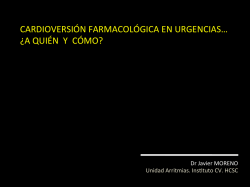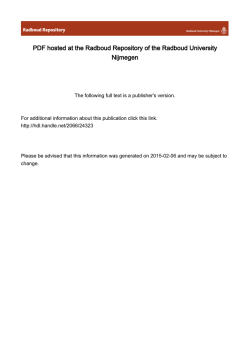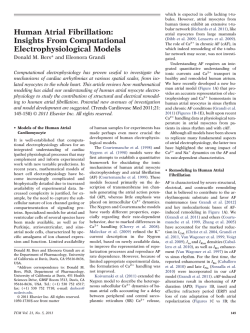
Acute Comparative Effect of Right and Left Ventricular Pacing in
Journal of the American College of Cardiology © 2004 by the American College of Cardiology Foundation Published by Elsevier Inc. Vol. 43, No. 2, 2004 ISSN 0735-1097/04/$30.00 doi:10.1016/j.jacc.2003.09.027 Electrophysiology Acute Comparative Effect of Right and Left Ventricular Pacing in Patients With Permanent Atrial Fibrillation Enrico Puggioni, MD,* Michele Brignole, MD,* Michael Gammage, MD,† Ezio Soldati, MD,‡ Maria Grazia Bongiorni, MD,‡ Emmanuael N. Simantirakis, MD,§ Panos Vardas, MD,§ Fredrik Gadler, MD, Lennart Bergfeldt, MD, Corrado Tomasi, MD,¶ Giacomo Musso, MD,# Gianni Gasparini, MD,** Attilio Del Rosso, MD†† Lavagna, Pisa, Reggio Emilia, Imperia, Mestre, and Fucecchio, Italy; Birmingham, United Kingdom; Heraklion, Greece; and Stockholm, Sweden We tested the hypothesis that left ventricular (LV) pacing is superior to right ventricular (RV) apical pacing in patients undergoing atrioventricular (AV) junction ablation and pacing for permanent atrial fibrillation. BACKGROUND The potential benefit of LV over RV pacing needs to be evaluated without the confounding effect of other variables that can influence cardiac performance. METHODS An acute intrapatient comparison of the QRS width and echocardiographic parameters between RV versus LV pacing was performed within 24 h after ablation in 44 patients. Both modes of pacing were also compared with pre-implantation values. RESULTS Compared with RV pacing, LV pacing caused a 5.7% increase in the ejection fraction (EF) and a 16.7% decrease in the mitral regurgitation (MR) score; the QRS width was 4.8% shorter with LV pacing. Similar results were observed in patients with or without systolic dysfunction and/or native left bundle branch block, except for a greater improvement in MR in the latter group. Compared with pre-ablation measures, the EF increased by 11.2% and 17.6% with RV and LV pacing, respectively; the MR score decreased by 0% and 16.7%; and the diastolic filling time increased by 12.7% and 15.6%. CONCLUSIONS Rhythm regularization achieved with AV junction ablation improved EF with both RV and LV pacing; LV pacing provided an additional modest but favorable hemodynamic effect, as reflected by a further increase of EF and reduction of MR. The effect seems to be equal in patients with both depressed and preserved systolic functions and in those with and without native left bundle branch block. (J Am Coll Cardiol 2004;43:234 – 8) © 2004 by the American College of Cardiology Foundation OBJECTIVES Pacing from the apex of the right ventricle (RV) is considered not optimal, as it provides a nonphysiologic asynchronous contraction, which results in a decrease in cardiac performance (1,2). In patients with permanent atrial fibrillation (AF) who received atrioventricular (AV) junction ablation and pacing from the RV apex, the beneficial See page 239 hemodynamic effect of regularization of heart rhythm is thus assumed to be partly counteracted by the adverse hemodynamic effect of a nonphysiologic pacing mode (3). From the Cardiology Departments, *Ospedali del Tigullio, Lavagna, Italy; †Queen Elizabeth Hospital, Birmingham, United Kingdom; ‡Ospedale S. Chiara, Pisa, Italy; §University Hospital, Heraklion, Greece; Karolinska Hospital, Stockholm, Sweden; ¶Ospedale S. Maria Nuova, Reggio Emilia, Italy; #Ospedale Civile, Imperia, Italy; **Ospedale Umberto I, Mestre, Italy; and ††Ospedale S. Pietro Igneo, Fucecchio, Italy. This study is officially endorsed by the Working Group on Pacing of the European Society of Cardiology. The Steering Committee was supported by a limited grant from Vitatron, The Netherlands, and St. Jude Medical, Italy, which have agreed not to interfere with the scientific issues of the study. Manuscript received June 14, 2003; revised manuscript received August 2, 2003, accepted September 8, 2003. Downloaded From: http://content.onlinejacc.org/ on 02/06/2015 The Optimal Pacing Site (OPSITE) study (4) is a prospective, randomized, single-blinded, cross-over comparison between RV and left ventricular (LV) pacing for patients with permanent AF undergoing ablation and pacing therapy. The study consists of acute and chronicevaluations. The protocol has been published previously (4). In this report, we focus on the acute comparison of RV and LV pacing in a model of AF and AV junction ablation, which allows the net effect of LV over RV pacing to be studied without the confounding effect of two other variables that can influence cardiac performance—namely, the effect of atrial contribution (including the effect of the PR interval) and the irregularity of the ventricular rhythm. Single-site LV pacing was compared with single-site RV pacing to eliminate the potential confounding effect of simultaneous biventricular stimulation. Moreover, the acute evaluation was performed shortly after ablation, allowing a minimum time for cardiac adaptation, which is another confounding factor. We assumed that the acute hemodynamic effect of LV pacing would be better than that of RV pacing. Secondary objectives were the comparison between two predefined Puggioni et al. LV Versus RV Pacing JACC Vol. 43, No. 2, 2004 January 21, 2004:234–8 235 Table 1. Patient Characteristics at Enrollment (n ϭ 49) Abbreviations and Acronyms AF ϭ atrial fibrillation AV ϭ atrioventricular EF ϭ ejection fraction LBBB ϭ left bundle branch block LV ϭ left ventricle/ventricular MR ϭ mitral regurgitation OPSITE ϭ Optimal Pacing Site study RV ϭ right ventricle/ventricular subgroups of patients with preserved or depressed systolic function and the comparison of the two modes of pacing with baseline measures to evaluate the effect of AV junction ablation. METHODS The following patients were eligible for enrollment in the OPSITE study: 1) patients with permanent AF in whom a clinical decision was made to undertake complete AV junction ablation and ventricular pacing because of a drugrefractory, severely symptomatic, uncontrolled high ventricular rate; and 2) patients with permanent AF, drugrefractory heart failure, depressed LV function, and/or left bundle branch block (LBBB) in whom a clinical decision was made to undertake LV synchronization pacing. Patient exclusion criteria were as follows: 1) New York Heart Association functional class IV heart failure; 2) severe concomitant noncardiac diseases; 3) need for surgical intervention; 4) myocardial infarction within three months; 5) sustained ventricular tachycardia or ventricular fibrillation; and 6) previously implanted pacemaker. Two different subgroups were predefined for analysis: patients with an ejection fraction (EF) Ͼ40% and absence of an LBBB pattern (group A) and patients with heart failure (i.e., those with EF Յ40% and/or LBBB pattern) (group B). All patients underwent pacemaker implantation and AV junction ablation; pacemaker implantation and ablation could take place at different times (Ͻ6 weeks apart), but simultaneous procedures were recommended. The RV leads were positioned in the RV apex. The LV leads were positioned via the coronary sinus in a position considered most appropriate by the implanting physician; in case of failure of pacing through the coronary sinus, an epicardial lead was inserted. A conventional dual-chamber pacemaker was used; the atrial port of the pacemaker was connected to the LV lead, and the ventricular port was connected to the RV lead. The acute noninvasive study, which was performed within 24 h after AV junction ablation, consisted of echocardiographic evaluation and measurements of the QRS duration. The pacemaker was alternately programmed to pace in the LV or RV only in randomized order, at a rate of 70 beats/min. The RV and LV pacing studies were performed during the same session; the operator who per- Downloaded From: http://content.onlinejacc.org/ on 02/06/2015 Age (yrs) Gender (males) Duration of atrial fibrillation (yrs) No. of hospitalizations per patient New York Heart Association functional class Minnesota Living With Heart Failure Questionnaire (score) 6-min walking test (m) Standard electrocardiogram Mean heart rate (beats/min) Left bundle branch block Other intraventricular conduction disturbances Holter monitoring Minimum heart rate (beats/min) Mean heart rate (beats/min) Maximum heart rate (beats/min) Associated structural heart disease Coronary artery disease Others Concomitant medications Digoxin Diuretics Nitrates Angiotensin-converting enzyme inhibitors Beta-blockers Calcium antagonists Apirin Warfarin Class I antiarrhythmic drugs Amiodarone Sotalol 72 Ϯ 8 24 (54%) 5.9 Ϯ 4.2 3.3 Ϯ 2.6 2.4 Ϯ 0.5 49 Ϯ 17 292 Ϯ 103 101 Ϯ 25 22 (50%) 10 (23%) 65 Ϯ 32 91 Ϯ 18 143 Ϯ 41 15 (34%) 29 (66%) 32 (72%) 35 (80%) 7 (16%) 33 (75%) 22 (50%) 10 (23%) 4 (9%) 37 (84%) 3 (7%) 7 (16%) 1 (2%) Data are presented as the mean value Ϯ SD or number (%) of patients. formed the test and analyzed the records was not informed of the mode of pacing. The echocardiographic examination was performed using standard views, according to the guidelines of the American Society of Echocardiography (5). Echocardiographic long-axis and apical two- and fourchamber views were obtained to assess the LV end-diastolic diameter, LV end-systolic diameter, EF (area–length method), aortic flow integral (pulsed Doppler), isovolumic relaxation time, mitral flow integral (pulsed Doppler), mitral flow peak, mitral deceleration time, diastolic filling time, and severity of mitral regurgitation (MR) (by means of a semiquantitative three-score scale). The measures obtained were the average of six consecutive beats. Statistical analysis. The assumption for the sample size calculation was that, based on a previous study (6), LV pacing would be able to increase EF by 9%, compared with RV pacing. The sample size able to provide 80% power to show an intrapatient difference, with a probability of 95%, was 40 patients. Paired and unpaired two-tailed t tests were used for comparison of continuous variables. A value p Ͻ 0.05 was considered as significant. RESULTS The study group consisted of 44 patients who had undergone successful AV junction ablation and pacemaker implantation between July 2001 and July 2002. The RV leads were positioned in the RV apex in all patients. The LV leads 236 Puggioni et al. LV Versus RV Pacing JACC Vol. 43, No. 2, 2004 January 21, 2004:234–8 Table 2. Results RV vs. Baseline EF (%) LVEDD (mm) LVESD (mm) IRT (ms) MR (score) FVI Ao (cm) Emax (cm/s) FVI (cm) DT (ms) DFT (ms) QRS (ms) LV vs. Baseline LV vs. RV Baseline RV Pacing LV Pacing Difference (%) p Value* Difference (%) p Value* Difference (%) p Value* 36.6 Ϯ 13.0 56.7 Ϯ 10.2 48.8 Ϯ 10.6 84.7 Ϯ 21.2 1.8 Ϯ 0.7 19.7 Ϯ 8.9 106.9 Ϯ 34.6 18.6 Ϯ 11.9 198 Ϯ 71.4 313 Ϯ 98 134 Ϯ 37 40.7 Ϯ 14.9 57.4 Ϯ 10.2 43.4 Ϯ 11.5 79.9 Ϯ 30.2 1.8 Ϯ 0.9 17.6 Ϯ 6.8 104.5 Ϯ 31.2 17.9 Ϯ 7.1 205 Ϯ 75 353 Ϯ 71 187 Ϯ 39 43.0 Ϯ 14.2 57.2 Ϯ 10.5 42.7 Ϯ 12.1 78.8 Ϯ 28.1 1.5 Ϯ 0.7 18.7 Ϯ 6.8 105.2 Ϯ 31.5 18.2 Ϯ 8.3 205 Ϯ 80 362 Ϯ 88 178 Ϯ 36 ϩ11.2 ϩ1.2 Ϫ11.1 Ϫ5.7 0 Ϫ10.7 Ϫ2.2 Ϫ3.6 ϩ3.5 ϩ12.7 ϩ37.5 0.03 NS NS NS NS 0.02 NS NS NS 0.02 0.001 ϩ17.5 ϩ0.9 Ϫ12.5 Ϫ7.0 Ϫ16.7 Ϫ5.1 Ϫ1.6 Ϫ2.2 ϩ3.5 ϩ15.6 ϩ30.9 0.001 NS NS NS 0.002 NS NS NS NS 0.004 0.001 ϩ5.7 Ϫ0.4 Ϫ1.6 Ϫ1.3 Ϫ16.7 ϩ6.2 ϩ0.4 ϩ1.7 0 ϩ2.5 Ϫ4.8 0.002 NS NS NS 0.001 NS NS NS NS NS 0.04 *Paired t test. Data are presented as the mean value Ϯ SD. DFT ϭ diastolic filling time; DT ϭ deceleration time; EF ϭ ejection fraction; Emax ϭ maximum protodiastolic mitral flow; FVI ϭ flow–velocity integral; FVI Ao ϭ aortic flow–velocity integral; IRT ϭ isovolumetric relaxation time; LV ϭ left ventricular; LVEDD ϭ left ventricular end-diastolic diameter; LVESD ϭ left ventricular end-systolic diameter; MR ϭ mitral regurgitation; NS ϭ not significant; RV ϭ right ventricular. were positioned via the coronary sinus in the midposterolateral site in 39 patients and in the anterior site in 3 patients. In two patients in whom the coronary sinus approach had failed, the lead was implanted in an epicardial mid-posterolateral position through a limited thoracotomy. The clinical characteristics are shown in Table 1. Of these, 14 belonged to group A and 30 to group B (22 of group B also had LBBB). The results of the comparison between RV and LV pacing are shown in Table 2. Compared with RV, LV pacing resulted in a significant increase of EF, a decrease of MR, and a small reduction of the QRS duration. Similar results were observed in patients with normal cardiac function (group A) and in those with depressed systolic function (group B) for all variables except for MR, which was more reduced in group A patients (Table 3). Similar findings were also observed in patients with and without native LBBB (Table 4). Among patients with native LBBB, all but three also had an EF Ͻ40%. A comparison with pre-implantation data is shown in Table 2. Both RV and LV pacing improved EF and prolonged the diastolic filling time; LV pacing also reduced the MR score, whereas RV pacing did not. Both RV and LV pacing decreased aortic and mitral stroke velocity, thus suggesting a deleterious effect on contraction, but this effect was less pronounced with LV pacing. DISCUSSION The main findings of this study are that rhythm regularization achieved with AV junction ablation improves EF with both RV and LV pacing; however, LV pacing gives an additive modest but favorable hemodynamic effect, as judged by a further increase of EF and reduction of MR magnitude. This effect seems to be equal in patients with and without depressed systolic function and in patients with and without LBBB. As a consequence of the protocol used, the effect of LV pacing could be evaluated without several potentially confounding factors (i.e., the effect of atrial contribution [including the effect of the PR interval], irregularity of the ventricular rhythm, simultaneous biven- Table 3. Comparison Between Group A and Group B Patients Group A (n ؍14) EF (%) LVEDD (mm) LVESD (mm) IRT (ms) MR (score) FVI Ao (cm) Emax (cm/s) FVI Mi (cm) DT (ms) DFT (ms) QRS (ms) Group A vs. Group B Group B (n ؍30) RV LV Difference (%) p Value* RV LV Difference (%) p Value* p Value† 53.8 Ϯ 12.9 50.4 Ϯ 6.1 34.6 Ϯ 5.7 67.9 Ϯ 25.7 2.2 Ϯ 1.0 18.2 Ϯ 6.1 107 Ϯ 39 18.8 Ϯ 7.8 210 Ϯ 51 347 Ϯ 48 179 Ϯ 33 55.6 Ϯ 11.1 50.0 Ϯ 6.6 33.0 Ϯ 6.3 70.2 Ϯ 24.1 1.5 Ϯ 0.7 18.9 Ϯ 6.8 109 Ϯ 38 19.4 Ϯ 10.4 207 Ϯ 58 372 Ϯ 74 168 Ϯ 27 ϩ3.5 Ϫ0.8 Ϫ3.7 3.4 Ϫ31.8 ϩ3.8 ϩ1.8 ϩ3.2 Ϫ1.4 Ϫ0.5 Ϫ6.1 NS NS 0.03 NS 0.005 NS NS NS NS NS NS 34.7 Ϯ 11.5 60.6 Ϯ 10.2 47.6 Ϯ 11.3 85.3 Ϯ 30.8 1.6 Ϯ 0.7 17.3 Ϯ 7.2 103.5 Ϯ 27.4 17.5 Ϯ 6.8 202.6 Ϯ 84.0 356.1 Ϯ 79.0 191 Ϯ 39 37.1 Ϯ 11.4 60.6 Ϯ 10.4 47.3 Ϯ 11.4 82.6 Ϯ 29.3 1.5 Ϯ 0.7 18.6 Ϯ 6.9 103.6 Ϯ 28.5 17.6 Ϯ 7.3 204.4 Ϯ 88.9 358.2 Ϯ 94.4 186 Ϯ 34 ϩ6.9 0 Ϫ0.6 Ϫ3.2 Ϫ6.3 ϩ7.5 0 ϩ0.6 ϩ0.8 ϩ0.6 Ϫ3.0 0.004 NS NS NS 0.02 NS NS NS NS NS NS NS NS NS NS 0.01 NS NS NS NS NS NS *Paired t test. †Unpaired t test for group A versus B. Data are presented as the mean value Ϯ SD. FVI Mi ϭ mitral flow–velocity integral; other abbreviations as in Table 2. Downloaded From: http://content.onlinejacc.org/ on 02/06/2015 Puggioni et al. LV Versus RV Pacing JACC Vol. 43, No. 2, 2004 January 21, 2004:234–8 237 Table 4. Comparison Between Patients With LBBB and Those Without No LBBB (n ؍22) EF (%) LVEDD (mm) LVESD (mm) IRT (ms) MR (score) FVI Ao (cm) Emax (cm/s) FVI Mi (cm) DT (ms) DFT (ms) QRS (ms) LBBB vs. No LBBB LBBB (n ؍22) RV LV Difference (%) p Value* RV LV Difference (%) p Value* p Value† 48.2 Ϯ 15.5 53.0 Ϯ 7.1 37.7 Ϯ 8.4 72.5 Ϯ 28.6 1.9 Ϯ 0.9 17.2 Ϯ 7.3 108.3 Ϯ 36.8 19.2 Ϯ 8.5 214 Ϯ 61 341 Ϯ 64 178 Ϯ 38 50.5 Ϯ 13.7 52.5 Ϯ 7.1 37.1 Ϯ 9.5 75.7 Ϯ 25.7 1.4 Ϯ 0.6 18.4 Ϯ 6.2 109.9 Ϯ 35.4 19.8 Ϯ 10.0 209 Ϯ 68 361 Ϯ 81 169 Ϯ 27 ϩ4.7 Ϫ0.5 Ϫ1.6 ϩ4.4 Ϫ26.4 ϩ6.9 ϩ1.4 ϩ3.1 Ϫ2.3 ϩ5.8 Ϫ5.1 NS NS NS NS 0.001 NS NS NS NS NS NS 33.3 Ϯ 9.7 61.8 Ϯ 11.1 49.1 Ϯ 11.6 87.3 Ϯ 30.5 1.7 Ϯ 0.8 17.9 Ϯ 6.4 100.8 Ϯ 24.6 16.5 Ϯ 4.8 196 Ϯ 87 367 Ϯ 78 196 Ϯ 36 35.5 Ϯ 10.4 62.0 Ϯ 11.4 48.4 Ϯ 11.9 81.9 Ϯ 30.6 1.5 Ϯ 0.8 18.9 Ϯ 7.5 100.4 Ϯ 27.0 16.3 Ϯ 5.6 202 Ϯ 92 363 Ϯ 99 190 Ϯ 35 ϩ6.6 ϩ0.3 Ϫ1.4 Ϫ6.2 Ϫ11.8 ϩ5.5 Ϫ0.1 Ϫ1.3 ϩ3.0 Ϫ0.3 Ϫ3.1 0.01 NS NS NS NS NS NS NS NS NS NS NS NS NS NS 0.03 NS NS NS NS NS NS *Paired t test. †Unpaired t test for LBBB versus no LBBB. Data are presented as the mean value Ϯ SD. LBBB ϭ left bundle branch block; other abbreviations as in Tables 2 and 3. tricular stimulation, and cardiac adaptation to chronic stimulation). An increase in EF over baseline was already present as a result of RV pacing. Because a direct improvement of cardiac function by RV pacing is unlikely, this improvement seems likely to be due to the effects of rhythm regularization and the reduction in the ventricular rate following AV junction ablation, resulting in improvements in ventricular filling, the Frank-Starling mechanism, and the intervalforce relation (7–10). In addition, RV pacing showed a neutral effect on MR and indeed a worsening of aortic and mitral flow, probably reflecting the asynchronous contraction caused by nonphysiologic pacing from the apex of the RV (1,2). Thus, the cardiac performance after AV junction ablation and RV pacing is the net result of two opposite effects. Left ventricular pacing, compared with RV pacing, substantially reduced the magnitude of MR and did not worsen aortic and mitral flow. The lessened MR tended to lower the EF because of higher afterloading conditions on the LV present during MR, unless inotropic/contractile performance was improved. In one study (11), functional MR was reduced in patients in sinus rhythm, and this effect was directly related to the increased closing force. In the present study, the EF improved by a further 6%, as compared with RV pacing (ϩ17% vs. baseline). Thus, the improvement of EF in the presence of less MR implies even more benefit from LV pacing. On the other hand, the aortic flow did not improve with LV pacing, as much as expected from the reduction of MR. Small changes in aortic flow may indicate that only a small reduction in MR took place. In brief, the observed modifications were generally modest and, in some way, contrasting. Anyway, in general, it seems that LV pacing is able to counteract some of the adverse effects of RV pacing. The acute hemodynamic effects of LV pacing were similar in the patients with preserved and depressed systolic function, as well as in patients with and without native LBBB. This finding is original. Indeed, until now, LV and Downloaded From: http://content.onlinejacc.org/ on 02/06/2015 biventricular pacing modes have been studied mainly in patients with severely compromised LV systolic function and LBBB. Pacing from the apex of the RV causes an electrocardiographic pattern of LBBB. In one study (12) performed in patients with otherwise normal hearts, the presence of LBBB was associated with a significant deterioration of cardiac function of about 10% to 20%. In the published data, the widely used criterion for LV (or biventricular) pacing is the presence of LBBB with a wide QRS complex (13–15). The criterion of a paced QRS width Ͼ200 ms was also used in one study (14). Our observation potentially extends the indication for LV pacing to all patients who are candidates for ablation and pacing therapy. This latter assertion needs to be verified in a larger population, as the present study is probably underpowered to show differences between subgroups. We cannot exclude some interobserver variability of echocardiographic evaluations that could confound the results. However, the intrapatient comparison allowed us to reduce the interobserver variability. There is increasing evidence for a favorable effect of cardiac resynchronization pacing in patients with heart failure and an intraventricular conduction delay, who are in sinus rhythm either during acute hemodynamic (16 –22) or clinical follow-up studies (6,23–28). Much less is known about patients with permanent AF. An acute hemodynamic study (13) showed similar hemodynamic benefits of LV-based pacing either in sinus rhythm or in AF. Capillary wedge pressure decreased from 24 Ϯ4 mm Hg at baseline to 19 Ϯ 5 mm Hg and 21 Ϯ 6 mm Hg during LV and biventricular pacing, respectively; aortic systolic blood pressure increased from 116 Ϯ 19 mm Hg baseline to 123 Ϯ 18 mm Hg and 121 Ϯ 18 mm Hg during LV and biventricular pacing, respectively. In another small, acute, controlled study (6), LV pacing, compared with RV pacing, caused an improvement of EF from 34 Ϯ 14% to 37 Ϯ 12% and in the aortic flow integral from 19 Ϯ 14 cm to 21 Ϯ 14 cm. The magnitude of the acute improvement is modest, 238 Puggioni et al. LV Versus RV Pacing however. It is uncertain how much these hemodynamic effects correlate with the clinical outcome. The results of the first randomized clinical study have recently been reported (14). The intention-to-treat analysis did not show any statistically significant difference in either the primary or secondary end points between biventricular and RV pacing; however, in the on-treatment analysis, the mean walked distance increased significantly by 9.3% and peak oxygen uptake increased by 13% during biventricular pacing. The average magnitude of the effect was modest, although very helpful, in terms of clinical improvement. This is not surprising if we consider that, in AF patients, an improvement is achieved by AV junction ablation, per se, which reduces the amount of the potential additional benefits obtainable through LV pacing. On the other hand, it is apparent from the published data that upgrading to biventricular pacing is greatly effective in patients with congestive heart failure with a low EF, who have had the previous intervention of AV junction ablation and RV pacing (29). The results of the chronic phase the OPSITE study (4) will hopefully help to increase our knowledge of the benefits of different pacing sites in these patients. Reprint requests and correspondence: Dr. Michele Brignole, Head of the Department of Cardiology, Ospedali del Tigullio, Via don Bobbio, 16033 Lavagna, Italy. E-mail: mbrignole@ASL4. liguria.it. REFERENCES 1. Zile M, Blaustein A, Shimizu G, et al. Right ventricular pacing reduces the rate of left ventricular relaxation and filling. J Am Coll Cardiol 1987;10:702–9. 2. Ausubel K, Furman S. The pacemaker syndrome. Ann Intern Med 1985;103:420 –9. 3. Brignole M, Menozzi C, Gianfranchi L, et al. Assessment of atrioventricular junction ablation and VVIR pacemaker versus pharmacological treatment in patients with heart failure and chronic atrial fibrillation: a randomized controlled study. Circulation 1998;98:953– 60. 4. Brignole M, Gammage M. An assessment of the optimal ventricular pacing site in patients undergoing ‘ablate and pace’ therapy for permanent atrial fibrillation. Europace 2001;3:153–6. 5. Schiller NB, Shah PM, Crawford M, et al. Recommendations for quantitation of the left ventricle by two-dimensional echocardiography. American Society of Echocardiography Committee on Standards, Subcommittee on Quantitation of Two-Dimensional Echocardiograms. J Am Soc Echocardiogr 1989;2:358 –67. 6. Lupi G, Brignole M, Oddone D, Bollini R, Menozzi C, Oddone D. Effects of left ventricular pacing on cardiac performance and quality of life in patients with drug-refractory heart failure. Am J Cardiol 2000;86:1267–70. 7. Clark D, Plumb V, Epstein A, Kay N. Hemodynamic effects of irregular sequences of ventricular cycle lengths during atrial fibrillation. J Am Coll Cardiol 1997;30:1039 –45. 8. Daoud E, Weiss R, Bahu M, et al. Effect of irregular ventricular rhythm on cardiac output. Am J Cardiol 1996;78:1433–6. 9. Herbert WH. Cardiac output and the varying RR interval of atrial fibrillation. J Electrocardiol 1973;6:131–5. 10. Gosselink M, Blanksma P, Crijns H, et al. Left ventricular beat-tobeat performance in atrial fibrillation: contribution of Frank-Starling mechanism after short rather than long RR interval. J Am Coll Cardiol 1995;26:1516 –21. Downloaded From: http://content.onlinejacc.org/ on 02/06/2015 JACC Vol. 43, No. 2, 2004 January 21, 2004:234–8 11. Breithard O, Sinha A, Schwammenthal E, et al. Acute effects of cardiac resynchronization therapy on functional mitral regurgitation in advanced systolic heart failure. J Am Coll Cardiol 2003;41:765–70. 12. Sadaniantz A, Laurent L. Left ventricular Doppler diastolic filling patterns in patients with isolated left bundle branch block. Am J Cardiol 1998;81:643–5. 13. Etienne Y, Mansourati J, Gilard M, et al. Evaluation of left ventricular based pacing in patients with congestive heart failure and atrial fibrillation. Am J Cardiol 1999;83:1138 –40. 14. Leclercq C, Walker S, Linde C, et al. Comparative effects of permanent biventricular and right-univentricular pacing in heart failure patients with chronic atrial fibrillation. Eur Heart J 2002;23: 1780 –7. 15. Leclerq C, Victor F, Alonso C, et al. Comparative effects of permanent biventricular pacing for refractory heart failure in patients with stable sinus rhythm or chronic atrial fibrillation. Am J Cardiol 2000;85: 1154 –6. 16. Blanc JJ, Etienne Y, Gilard M, et al. Evaluation of different ventricular pacing sites in patients with severe heart failure: results of an acute hemodynamic study. Circulation 1997;96:3273–7. 17. Kass D, Chen-Huan C, Curry C, et al. Improved left ventricular mechanics from acute VDD pacing in patients with dilated cardiomyopathy and ventricular conduction delay. Circulation 1999;99:1567– 73. 18. Auricchio A, Stellbrink C, Block M, et al. Effect of pacing chamber and atrioventricular delay on acute systolic function of paced patients with congestive heart failure. Circulation 1999;99:2993–3001. 19. Leclercq C, Cazeau S, Le Breton H, et al. Acute hemodynamic effects of biventricular DDD pacing in patients with end-stage heart failure. J Am Coll Cardiol 1998;32:1825–31. 20. Nelson G, Berger R, Fetics B, et al. Left ventricular or biventricular pacing improves cardiac function at diminished energy costs in patients with dilated cardiomyopathy and left bundle branch block. Circulation 2000;103:3053–9. 21. Yu CM, Chau E, Sanderson J, et al. Tissue Doppler echocardiographic evidence of reverse remodeling and improved synchronicity by simultaneous delaying regional contraction after biventricular pacing therapy in heart failure. Circulation 2002;105:438 –45. 22. Butter C, Auricchio A, Stellbrink C, et al. Effect of resynchronization therapy stimulation site on the systolic function of heart failure patients. Circulation 2001;104:3026 –9. 23. Stellbrink C, Breithardt OL, Franke A, et al. Impact of cardiac resynchronization therapy using hemodynamically optimized pacing on left ventricular remodeling in patients with congestive heart failure and ventricular conduction disturbances. J Am Coll Cardiol 2001;38: 1957–65. 24. Touiza A, Etienne Y, Gilard M, Fatemi M, Mansourati J, Blanc JJ. Long-term left ventricular pacing: assessment and comparison with biventricular pacing in patients with severe congestive heart failure. J Am Coll Cardiol 2001;38:1966 –70. 25. Cazeau S, Leclercq C, Lavergne T, et al. Effects of multisite biventricular pacing in patients with heart failure and intraventricular conduction delay. N Engl J Med 2001;344:873–80. 26. Auricchio A, Stellbrink C, Sacks S, et al. Long-term clinical effect of hemodynamically optimized cardiac resynchronization therapy in patients with heart failure and ventricular conduction delay. J Am Coll Cardiol 2002;39:2026 –33. 27. Abraham W, Fisher W, Smith A, et al. Cardiac resynchronization in chronic heart failure. N Engl J Med 2002;346:1845–53. 28. Saxon L, De Marco T, Schafer J, et al. Effects of long-term biventricular stimulation for resynchronization on echocardiographic measures of remodeling. Circulation 2002;105:1304 –10. 29. Leon A, Greenberg J, Kanaru N, et al. Cardiac resynchronization in patients with congestive heart failure and chronic atrial fibrillation. J Am Coll Cardiol 2002;39:1258 –63. APPENDIX For the Study Organization, Steering Committee, Executive Committee, and Data and Statistical Analysis, please see the January 21, 2004, issue of JACC at www.cardiosource.com/jacc.html.
© Copyright 2026
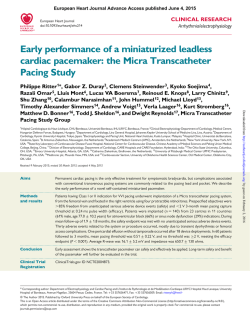

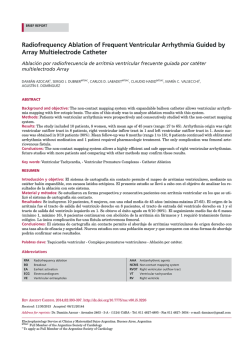
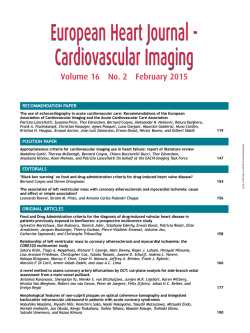
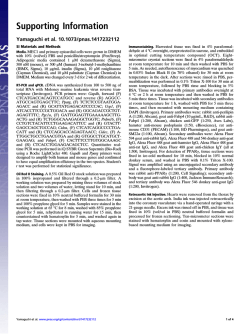
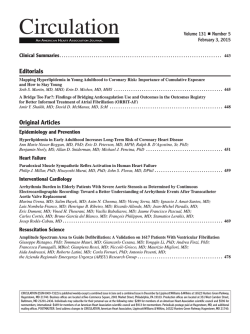
![Program - divine [id]](http://s2.esdocs.com/store/data/000470652_1-6d8f29df4fa45e08df5ac6fab3afd084-250x500.png)
